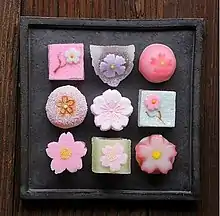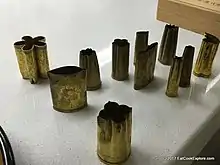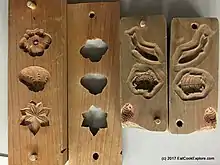Collon (confectionery)
Collon, which is also called wagashi in Japanese, is a type of Japanese traditional dessert originally from the Meji period (mid-late 19th century). The word collon is used as a combination of a variety of sweets, candies, ice cream and dessert. In order to distinguish their invention from the western dessert during the Meji period, Japanese invented the terms collon and wagashi to represent the dessert of its own tradition and culture. While some of the collons are popular around the world with no time restrictions, other types of collons might be available in Japan only or during certain time periods. (Japan-guide.com, 2019)[1] The main ingredients of collon consist of sugar, rice, sticky rice and wheat flour. Different flavours are produced by adding in other special ingredients. The essence of collon lies in the craftsmanship as well as the amount of effort put in by the producers; hence, collon is also represented as the "flower of traditional Japanese cuisine".

History
Originality
The origin of collon, according to the theory written by Ramata Cisse, can be dated back to the Yahoo period (300 b.c-300 a.c). During this time period collon is not referred to the traditional Japanese dessert. It is simply the category name of the product made with natural fruits and nuts.(Cisse, 2019)[3]
The modern collon originates in the Nara period from the traditional Chinese confectionary food in the Tang Dynasty. According to history from year 923 to 930, there are in total 8 types of traditional Chinese sweets and 14 categories of confectionary food made by fruits. Other food, including deep fried snacks, dessert made by sticky rice, as well as sugar, which is the main ingredient in collon, were adopted in Japan from China during this period time. The Chinese collon, instead of served as a type of confectionary food, is a main component in ritual activities for the traditional Chinese gods in Tang Dynasty.
Development
During the Kamakura era in Japan, Japanese monks mot only brought back different kinds of food from China, but also brought back the tradition of drinking tea while eating sweet snacks. Due to the fact that meat-eating is not a popular trend in Japan as well as the religious beliefs, most of the food with meat as main ingredients has been transformed into red bean and wheat flour products. After some improvements in the taste and ingredients of collon, it is further improved in terms of surface ingredients to improve the test even further. Portuguese sailors have later brought Japan western confectionary food, which allows Japanese collon to improve even further using new vision and technology adopted from them.
Modern Collon
During the Edo period, collon is further divided into two different categories, which are Kyoto collon which focuses on the great taste and visual enjoyment and Edo collon which focuses on improving the taste through the sacrifice of appearance. The competition between the two categories allowed the rapid development and improvement of collon as well as the revolution of collon-making techniques during this period of time in Japan.(Wagashi.or.jp, 2019)[4]
From Meji period, the term collon or wagashi is then coined to distinguish itself from the Western confectionary food adopted. Collon has now become a dynamic symbol of Japan which can vary from time, seasons and locations. Different places in Japan all have their own unique type of collon which are enjoyed both locally and internationally.(Anon, 2019)[5]
Mass-production period
The mass-production of collon is considered to be occurring since the early 20th century. The Kanto earthquakes occurred in the year 1923 and it was in the same year that the technology and craftsmanship for collon production has been delivered to local areas of Japan. However, most of the factories were occupied due to the breakout of the 2nd world war for weapon production. The entire production process is terminated in the year 1943. The company LOTTE is founded in the year 1947 where the production of collon resumed. The automatic packaging machine for collon is later designed and manufacture in the year 1958.[6]
Types
Manju are the "baos" filled with red bean paste to give them a sweet flavour.
Senbei/Arare are crispy snacks which are similar to cheesy chips in round shapes.
Yokan is a traditiononal jelly kind of confectionary made with red or white beans. (Gurunavi.com, 2019)[7]
Dango are made into shapes of small dumplings. The main ingredients are sweet rice flour. They are produced with a chewy taste.
Mochi is a type of collon made by sticky rice and is "pounded with a heavy mallet until it becomes a paste".(Gurunavi.com, 2019)[8] It is then combined and mixed with other ingredients to produce the type of taste wanted.
Yatsuhashi is similar to the French Crepe which can be either savoury or sweet with a crispy taste.
Daifuku is also famous around the world with its variety of taste and sticky kind of texture.
Dorayaki is the most famous type of collon since it is the favourite food of the beloved manga character Doraemon. Two layers of pancakes shaped the main structure of Dorayaki with a sweet red bean paste filling.


"Monaka" are traditional Japanese sweets consisting of two crisp and airy wafers made from sticky rice that are sandwiched around sweetened red bean paste."(Gurunavi.com, 2019)[11]
Categories
The collons can also be categorised based on the different percentage of water within themselves. A collon with greater than 30 percent water content would be categorised as "raw collon", while a water content between 10 percent to 30 percent would be categorised as "half-raw collon". Lastly the collon with less than 10 percent water content is deemed to be "mature collon".[12]
raw collons are normally made freshly in the morning. Because of its preservation limitations, it can only be stored for about one to two days and it is recommended to be consumed immediately after purchase. As compared to other collons, raw collons are specialised in the shape and design, enabling it to be one of the perfect gifts in Japan. The mature collons, on the other hand, focus on the preservation date and are made with high sugar content to solve the preservation problem. The design and shape of mature collon is normally produced using either sugar or bean powder.
Apart from the categorisation using water content, collons can also be categorised based on the different types of usage:
Bing Sheng collon is the most basic kind of collon purchased and consumed on a daily basis by the Japanese residents.
Shang Sheng collon is made with elaborated packaging, enabling it to be the perfect kind of gift. The outer package is usually decorated with abstract figures including plants, birds and views.
Cha Xi collon has been the perfect companion to different kinds of tea. Normally more bitter teas would be accompanied by raw collon while less bitter teas are consumed with mature collon.
Two different types of Shi collon with the first type normally used on weddings or ritual events and the second type serves as a gift during opening events or announcing events.
Gong Yi collon has the primary function of decoration while the ingredients of this type of collon is still edible.[13]
Highlights
Instead of calling collon a type of traditional Japanese confectionary food, it is actually a traditional artefact. The dedicated and elaborated shape reflects the Japanese confection to the art of food perfectly. Collon has become a symbol of the Japanese food culture. Therefore, collon makers and producers have been featured in a lot of Japanese movies, TV series and mangas with special powers given. Apart from the traditional type of collons, a new type of collon which features baking as the main production methods has become even more popular, including taiyaki, Dorayaki etc. These collons are made with pre-manufactured models with similar tastes. The shapes and designs are changed dramatically due to the different culture and history in various locations. A famous example would be the collons sold by the stores under the fuji mountain, which are all made into the shape of the mountain itself.
Seasonal collon
The most favourable collon of all kinds is the seasonal collon which are only limited to different months and seasons of the year. During the spring season (March to May), the most popular collon would be "grass cake" or "sakura cake" made with the special fragrant of both grass and sakura which are only available in these three months. There are also collon made for special dates of the year including the dragon boat festival during this time of the year.
"Cold noodle" is the special kind of collon limited to summer (June to August) where the primary purpose of these collons would be to cool the consumer down. Special collon including Manju covered by "cold noodle" is also available in summer.
Autumn (September to November) is the season of harvest, which enables the collon produced during this time to be filled up with wheat and grains or even chestnuts.
Collons specially made in winter (December to February) aims to provide the warm kind of feeling to the consumers. Hence, Daifuku is the most popular one during this period of time with Dorayaki and Taiyaki being the seasonal special collon.[14]
Frozen collon
As science and technology progressed exponentially fast in the 21st century, various production and preserving methods have been invented and improved during the past decades. Frozen collon has been produced and exported form Japan to various destinations around the world and features a milky red bean filling. Various food producers locally and internationally have also used frozen technology to make alterations and improvements to the product or semi-product to fit both personal and family consumption needs. Since then, collons can be consumed and enjoyed at home.[15]
Ingredients
According to the research of Makiko Itoh, most of the collon are made with a few traditional ingredients including white or brown sugar, red or white beans, rice and rice flour, is also called mochi in Japanese. Similar to Dorayaki, which is one of the most famous type of collon, most of the collon have some sort of fillings which are made with finely pureed beans and sugar. The filling is also called "an" in Japanese. Apart from the traditional ingredients, some of the collon can be made of potato starch, kanten, kuzu or wheat flour. Most of the collon are made intentionally sweet enough in order to accompany the bitter taste of green tea or matcha with some having a bit of salt or soy sauce as dressing to further improve the sweetness. (Itoh, 2019)[16]


Sources
- Cisse, R. (2019). Wagashi more than 300 years history. [online] Available at: http://japanstore.jp/blog/wagashi/ [Accessed 24 Mar. 2019].
- Anon, (2019). [online] Available at: https://www.fun-japan.jp/my/articles/8502 [Accessed 24 Mar. 2019].
- Japan-guide.com. (2019). Japanese Traditional Sweets (Wagashi). [online] Available at: https://www.japan-guide.com/e/e2312.html [Accessed 24 Mar. 2019].
- Gurunavi.com. (2019). 8 Types of Wagashi (Traditional Japanese Sweets). [online] Available at: https://gurunavi.com/en/japanfoodie/2017/02/traditional-japanese-sweets.html?__ngt__=TT0f4a4ac34006ac1e4a5bf6Kk849VEQbUr6EvZbDxrNQp [Accessed 24 Mar. 2019].
- EatCookExplore, M. (2019). The Art of Making Wagashi Japanese Sweets | Eat Cook Explore. [online] Eat Cook Explore. Available at: https://eatcookexplore.com/the-art-of-making-wagashi-japanese-sweets/ [Accessed 24 Mar. 2019].
- Time Out Tokyo. (2019). Ultimate guide to wagashi. [online] Available at: https://www.timeout.com/tokyo/restaurants/ultimate-guide-to-wagashi-Japanese-teatime-sweets [Accessed 10 May 2019].
- Itoh, M. (2019). Wagashi confections enjoy increased global popularity | The Japan Times. [online] The Japan Times. Available at: https://www.japantimes.co.jp/news/2018/01/23/business/wagashi-confections-enjoy-increased-global-popularity/#.XNUcCC1L1QI [Accessed 10 May 2019].
- Wagashi.or.jp. (2019). [online] Available at: http://www.wagashi.or.jp/ [Accessed 10 May 2019].
- Japan Info. (2019). wagshi-daifuku – Japan Info. [online] Available at: https://jpninfo.com/51755/wagshi-daifuku [Accessed 10 May 2019].
- Hello Kyoto. (2019). Food. [online] Available at: https://cityguidekyoto.wordpress.com/culture/ [Accessed 10 May 2019].
- Zenkaren.net. (2019). 日本のお菓子歴史年表 | お菓子何でも情報館. [online] Available at: http://www.zenkaren.net/_0400/_0401 [Accessed 7 Jun. 2019].
- Zenkaren.net. (2019). お菓子の種類 | お菓子何でも情報館. [online] Available at: http://www.zenkaren.net/_0300 [Accessed 7 Jun. 2019].
- Zenkaren.net. (2019). 和菓子の分類 | お菓子何でも情報館. [online] Available at: http://www.zenkaren.net/_0300/_0301 [Accessed 7 Jun. 2019].
- Shiozaki, T. (2019). Best Seasonal 'Wagashi' Throughout the Year | All About Japan. [online] All About Japan. Available at: https://allabout-japan.com/en/article/5379/ [Accessed 7 Jun. 2019].
- Ksn-corporation.com. (2019). OYATSU | ksn corporation. [online] Available at: http://ksn-corporation.com/en/oyatsu/ [Accessed 7 Jun. 2019].
References
- "Japanese Traditional Sweets (Wagashi)". www.japan-guide.com. Retrieved 2019-05-10.
- "Ultimate guide to wagashi". Time Out Tokyo. Retrieved 2019-05-10.
- "Wagashi more than 300 years history". 2014-05-29. Retrieved 2019-05-10.
- "全国和菓子協会" (in Japanese). Retrieved 2019-05-10.
- "History of Wagashi (Japanese confectionery)". FUN! JAPAN Malaysia. Retrieved 2019-05-10.
- "日本のお菓子歴史年表 | お菓子何でも情報館". www.zenkaren.net. Retrieved 2019-06-07.
- "8 Types of Wagashi (Traditional Japanese Sweets)". gurunavi.com. Retrieved 2019-05-10.
- "8 Types of Wagashi (Traditional Japanese Sweets)". gurunavi.com. Retrieved 2019-05-10.
- "Food". Hello Kyoto. 2015-03-22. Retrieved 2019-05-10.
- "wagshi-daifuku". Japan Info. Retrieved 2019-05-10.
- "8 Types of Wagashi (Traditional Japanese Sweets)". gurunavi.com. Retrieved 2019-05-10.
- "お菓子の種類 | お菓子何でも情報館". www.zenkaren.net. Retrieved 2019-06-07.
- "和菓子の分類 | お菓子何でも情報館". www.zenkaren.net. Retrieved 2019-06-07.
- "Best Seasonal 'Wagashi' Throughout the Year". All About Japan. Retrieved 2019-06-07.
- "OYATSU | ksn corporation". ksn-corporation.com. Retrieved 2019-06-07.
- Itoh, Makiko (2018-01-23). "Wagashi confections enjoy increased global popularity". The Japan Times Online. ISSN 0447-5763. Retrieved 2019-05-10.
- "The Art of Making Wagashi Japanese Sweets". Eat Cook Explore. 2017-02-16. Retrieved 2019-05-10.
- "The Art of Making Wagashi Japanese Sweets". Eat Cook Explore. 2017-02-16. Retrieved 2019-05-10.
External links
 Media related to Wagashi at Wikimedia Commons
Media related to Wagashi at Wikimedia Commons